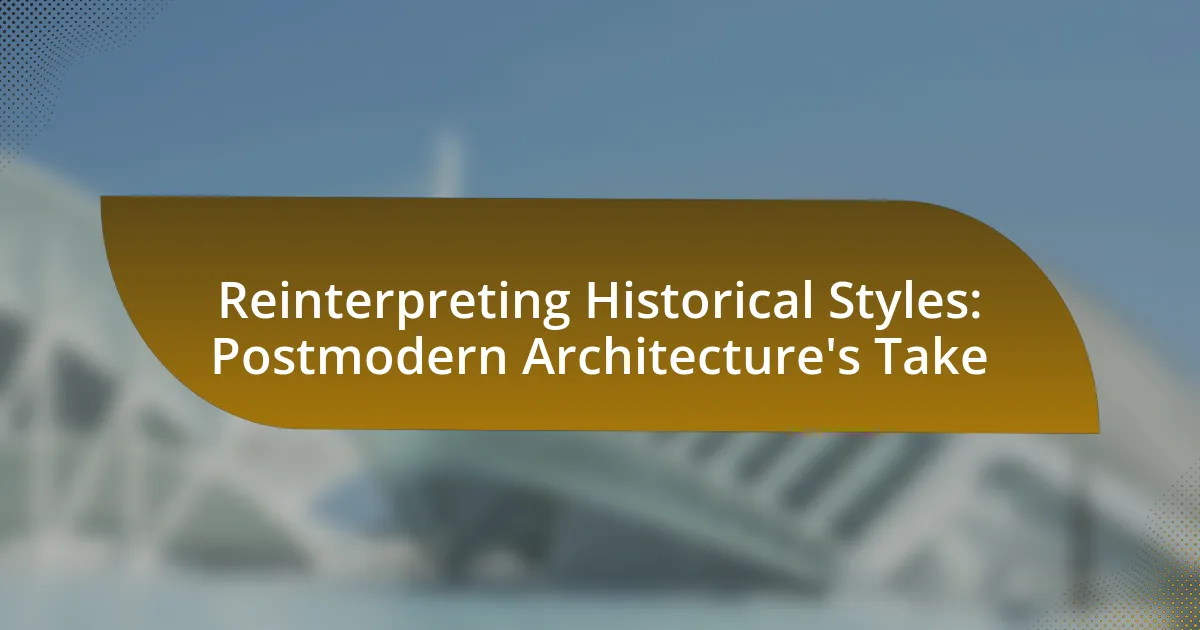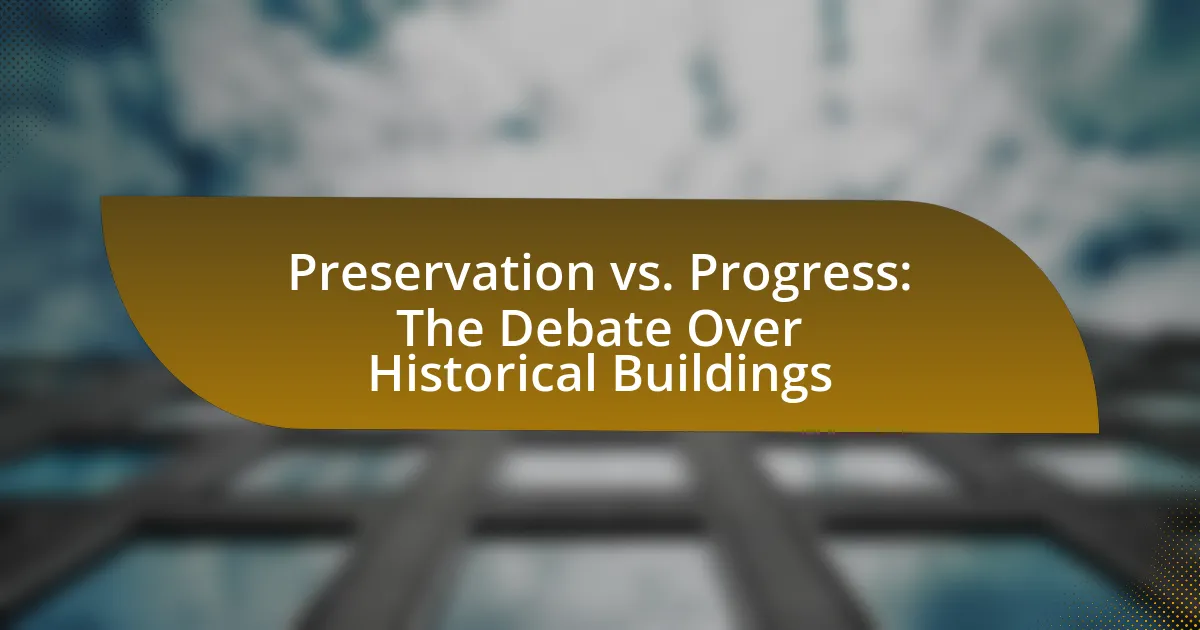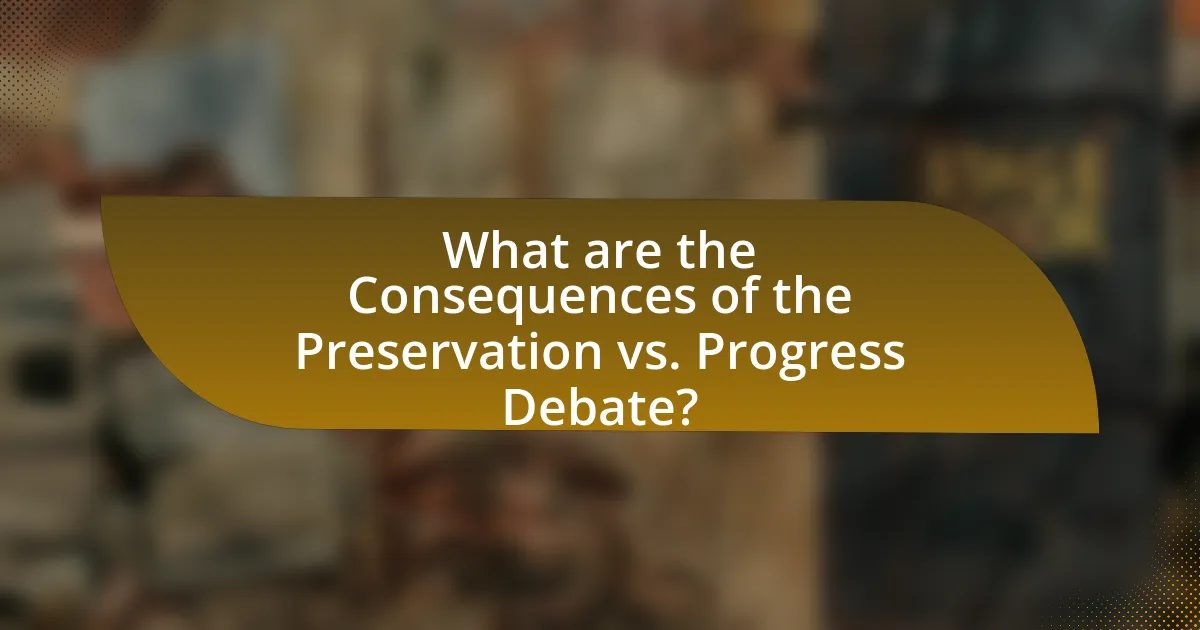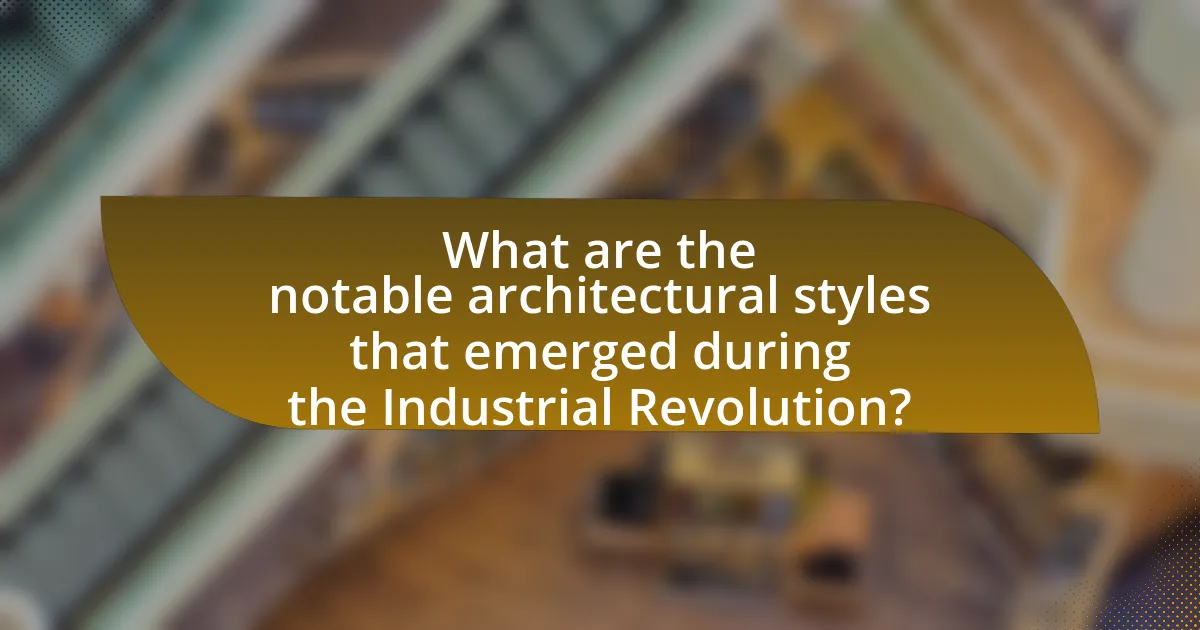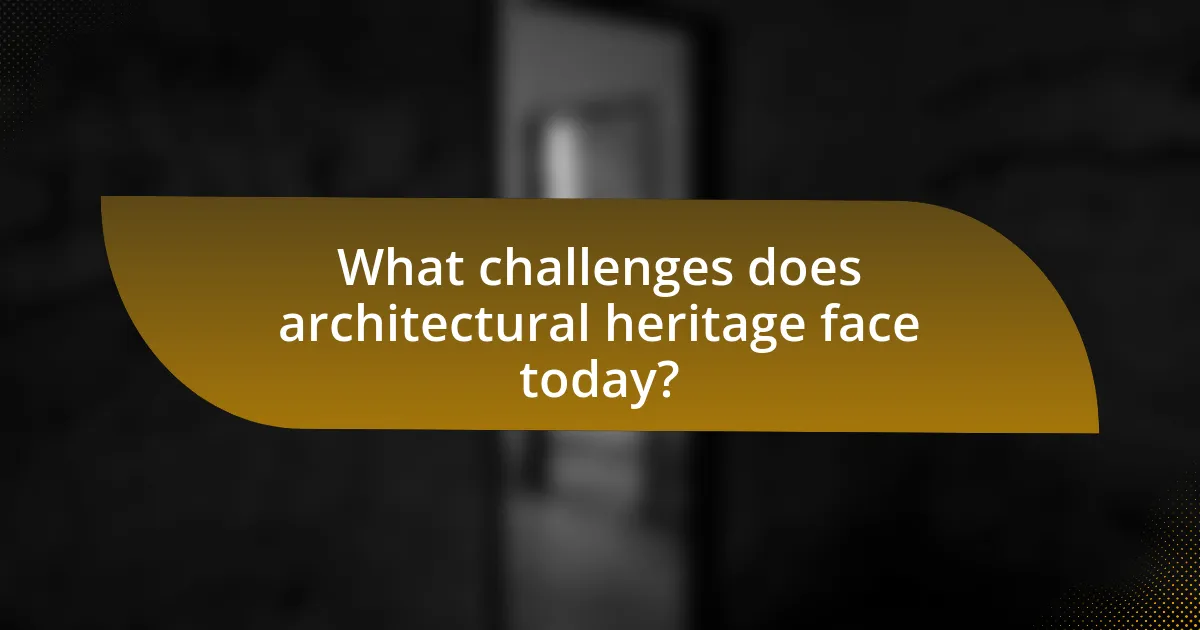The article examines the impact of colonialism on Indigenous architectural practices, highlighting how foreign design principles and materials disrupted traditional building techniques. It discusses the forced assimilation of Indigenous communities, leading to the abandonment of their architectural heritage in favor of colonial styles, and the introduction of European construction methods that altered the cultural significance of Indigenous architecture. The article further explores the historical contexts of Indigenous architectural practices prior to colonialism, the long-term effects of colonialism on contemporary Indigenous architecture, and the challenges faced by Indigenous architects in preserving traditional practices. Additionally, it emphasizes the importance of cultural revival and collaboration between Indigenous and non-Indigenous architects in revitalizing Indigenous architectural heritage.

What is the Impact of Colonialism on Indigenous Architectural Practices?
Colonialism significantly disrupted Indigenous architectural practices by imposing foreign design principles and materials, leading to the erosion of traditional building techniques. Indigenous communities often faced forced assimilation, which resulted in the abandonment of their architectural heritage in favor of colonial styles that reflected the colonizers’ cultural values. For instance, in North America, the introduction of European construction methods and materials, such as brick and timber framing, replaced traditional structures like earth lodges and longhouses. This shift not only altered the physical landscape but also diminished the cultural significance of Indigenous architecture, as buildings were no longer expressions of community identity and spirituality. Historical evidence shows that many Indigenous groups were compelled to adapt their architectural practices to meet colonial regulations, further marginalizing their traditional knowledge and craftsmanship.
How did colonialism influence the design and construction of indigenous structures?
Colonialism significantly influenced the design and construction of indigenous structures by introducing European architectural styles, materials, and building techniques. Indigenous communities often adapted their traditional designs to incorporate elements such as brick and stone, which were not commonly used in their original constructions. For instance, in regions like India, the British colonial period saw the introduction of Victorian architectural styles, which led to the blending of local designs with colonial aesthetics, resulting in hybrid structures like Indo-Saracenic architecture. This fusion altered the cultural significance of indigenous buildings, as they began to reflect colonial power dynamics and the imposition of foreign values on local practices.
What traditional architectural elements were altered or replaced during colonial rule?
During colonial rule, traditional architectural elements such as indigenous building materials, construction techniques, and spatial organization were significantly altered or replaced. Colonial powers often imposed their architectural styles, leading to the introduction of brick and stone structures that replaced traditional mud and thatch homes. For example, in India, the British introduced Victorian-style buildings, which contrasted sharply with local vernacular architecture. Additionally, colonial rule often resulted in the reorganization of urban spaces, with the establishment of grid patterns and public squares that disrupted traditional community layouts. This transformation reflects a broader trend of cultural imposition and the prioritization of colonial aesthetics over indigenous practices.
How did colonial policies affect the materials used in indigenous architecture?
Colonial policies significantly altered the materials used in indigenous architecture by imposing restrictions on traditional building practices and introducing foreign materials. Indigenous communities were often forced to abandon locally sourced materials, such as clay, wood, and stone, due to colonial regulations that favored the use of imported materials like brick and concrete. For instance, in many regions, colonial administrations prioritized the construction of European-style buildings, which led to the depletion of local resources and the marginalization of indigenous architectural techniques. This shift not only changed the physical landscape but also disrupted cultural practices associated with traditional building methods, as seen in various colonial territories where indigenous structures were replaced or modified to align with colonial aesthetics and regulations.
What are the historical contexts of indigenous architectural practices before colonialism?
Indigenous architectural practices before colonialism were deeply rooted in the cultural, environmental, and social contexts of various indigenous communities. These practices were characterized by the use of locally available materials, such as wood, stone, and earth, which were shaped by the specific climatic and geographical conditions of each region. For instance, the Pueblo peoples of the American Southwest constructed adobe dwellings that reflected their adaptation to arid environments, while the Inuit built igloos from snow to insulate against extreme cold.
Additionally, indigenous architecture often served multifunctional purposes, integrating living spaces with ceremonial and communal areas, which reinforced social cohesion and cultural identity. The designs were influenced by spiritual beliefs, as seen in the sacred geometry of many structures, which embodied cosmological principles. Historical evidence, such as archaeological findings and oral histories, supports the understanding that these architectural practices were not only functional but also integral to the cultural heritage and identity of indigenous peoples prior to colonial encounters.
What were the primary functions of indigenous architecture prior to colonial influence?
The primary functions of indigenous architecture prior to colonial influence included shelter, cultural expression, and community organization. Indigenous structures were designed to provide protection from environmental elements, reflecting the local climate and available materials, such as wood, stone, and earth. For example, the igloos of the Inuit served as insulated homes in Arctic conditions, while the adobe dwellings of the Pueblo peoples were suited for the arid Southwest.
Additionally, indigenous architecture often embodied cultural significance, with designs and layouts that represented spiritual beliefs and social structures. For instance, many Native American tribes constructed ceremonial sites that were integral to their cultural practices. Furthermore, the arrangement of living spaces facilitated community interaction and social cohesion, as seen in the longhouses of the Haudenosaunee, which housed multiple families and promoted communal living.
These functions illustrate how indigenous architecture was deeply intertwined with the environment, culture, and social organization prior to the disruptions caused by colonial influence.
How did cultural beliefs shape indigenous architectural styles?
Cultural beliefs significantly shaped indigenous architectural styles by influencing the design, materials, and functions of structures. For instance, many indigenous communities incorporated spiritual and cosmological elements into their architecture, reflecting their beliefs about the relationship between the natural and supernatural worlds. In the case of the Navajo, their hogans are oriented to align with cardinal directions, which is rooted in their cultural cosmology. Similarly, the use of local materials, such as adobe in Pueblo architecture, not only demonstrates environmental adaptation but also embodies cultural significance, as these materials are often tied to ancestral practices and beliefs. This integration of cultural beliefs into architectural styles illustrates how indigenous peoples express their identity and worldview through the built environment.
What are the long-term effects of colonialism on contemporary indigenous architecture?
Colonialism has led to significant long-term effects on contemporary indigenous architecture, primarily through the imposition of foreign architectural styles and the disruption of traditional building practices. This influence is evident in the blending of indigenous designs with colonial elements, resulting in hybrid structures that reflect both cultural loss and adaptation. For instance, in North America, many indigenous communities have incorporated modern materials and techniques into their traditional designs, often as a response to colonial policies that marginalized their architectural heritage. Additionally, the loss of land and resources due to colonial expansion has forced many indigenous peoples to adapt their architectural practices to urban environments, leading to a decline in the use of traditional materials and methods. This shift has been documented in studies such as “Indigenous Architecture and the Colonial Legacy” by authors from the University of British Columbia, which highlights how colonial histories continue to shape the built environment of indigenous communities today.
How have indigenous communities adapted their architectural practices post-colonialism?
Indigenous communities have adapted their architectural practices post-colonialism by integrating traditional building techniques with modern materials and designs. This adaptation reflects a response to the loss of land and resources, as well as a desire to reclaim cultural identity. For instance, many communities now utilize sustainable materials such as bamboo and reclaimed wood, which align with their ancestral practices while also addressing contemporary environmental concerns. Additionally, architectural designs often incorporate elements that reflect indigenous cultural symbols and community needs, fostering a sense of belonging and continuity. This evolution demonstrates resilience and innovation in the face of colonial disruption, as seen in projects like the Maori marae in New Zealand, which blend traditional forms with modern functionality.
What role does cultural revival play in modern indigenous architecture?
Cultural revival plays a crucial role in modern indigenous architecture by re-establishing traditional design principles and practices that were suppressed during colonialism. This revival fosters a sense of identity and community among indigenous peoples, allowing them to reclaim their heritage through architecture that reflects their cultural narratives and values. For instance, the incorporation of traditional materials and techniques, such as earth-based construction methods, not only honors ancestral practices but also promotes sustainability. Additionally, projects like the Indian Community School in Milwaukee, designed by indigenous architects, exemplify how cultural revival can lead to spaces that resonate with indigenous identity while addressing contemporary needs. This architectural movement is supported by various indigenous-led initiatives that emphasize the importance of cultural expression in the built environment, reinforcing the connection between architecture and cultural identity.

How did colonialism reshape the relationship between indigenous peoples and their built environment?
Colonialism fundamentally altered the relationship between indigenous peoples and their built environment by imposing foreign architectural styles and urban planning concepts that often disregarded traditional practices. This shift led to the dismantling of indigenous structures and the appropriation of land for colonial purposes, resulting in the loss of cultural identity and heritage. For instance, in North America, the introduction of European-style settlements disrupted the existing relationships indigenous communities had with their landscapes, as seen in the forced relocation of tribes and the establishment of towns that prioritized colonial needs over indigenous ways of living. This transformation not only marginalized indigenous architectural practices but also created a lasting impact on their social and cultural frameworks, as traditional knowledge and skills were undermined or lost.
What changes occurred in land use and ownership due to colonialism?
Colonialism significantly altered land use and ownership by transferring control from indigenous populations to colonial powers. Indigenous peoples often lost their ancestral lands through treaties, force, or legal manipulations, leading to a shift in land ownership to colonial governments and settlers. For instance, in North America, the Doctrine of Discovery facilitated the appropriation of land, allowing European settlers to claim territories inhabited by Native Americans, fundamentally changing land use from communal and subsistence practices to private ownership and commercial agriculture. This transition not only disrupted traditional land management practices but also imposed new agricultural methods and land use patterns that prioritized export-oriented production, as seen in the Caribbean with sugar plantations.
How did colonial land policies impact indigenous architectural practices?
Colonial land policies significantly disrupted indigenous architectural practices by enforcing land dispossession and altering traditional building methods. These policies often led to the forced relocation of indigenous communities, which resulted in the loss of access to culturally significant sites and materials essential for their architectural styles. For instance, in North America, the implementation of the Dawes Act in 1887 fragmented tribal lands, compelling Native Americans to abandon communal living structures in favor of individual homesteads, which diminished the use of traditional communal architectural forms. Additionally, colonial authorities frequently imposed European architectural styles and building regulations, undermining indigenous designs and techniques that had evolved over centuries. This imposition not only altered the physical landscape but also eroded cultural identity, as indigenous peoples were pressured to conform to foreign architectural norms.
What were the effects of displacement on indigenous architectural heritage?
Displacement significantly eroded indigenous architectural heritage by disrupting traditional building practices and cultural expressions. The forced relocation of indigenous communities often led to the abandonment of ancestral lands, resulting in the loss of knowledge related to local materials and construction techniques. For instance, the displacement of Native American tribes during the 19th century resulted in the destruction of traditional structures, such as longhouses and pueblos, which were integral to their cultural identity. Additionally, the imposition of colonial architectural styles further marginalized indigenous designs, leading to a homogenization of built environments that disregarded local traditions. This loss is evidenced by the decline in the number of traditional structures and the fading of associated cultural practices, as documented in studies on the impact of colonial policies on indigenous communities.
In what ways did colonial architecture influence indigenous building techniques?
Colonial architecture influenced indigenous building techniques primarily through the introduction of new materials, construction methods, and design aesthetics. For instance, the use of brick and stone became more prevalent among indigenous builders as they adopted these materials from colonial structures, which contrasted with traditional methods that relied on local resources like wood and mud. Additionally, colonial architectural styles, such as the use of arches and symmetrical layouts, were integrated into indigenous designs, leading to hybrid structures that reflected both colonial and indigenous influences. Historical examples include the adaptation of Spanish colonial architecture in Latin America, where indigenous communities incorporated European elements into their traditional homes, resulting in unique architectural forms that showcased this cultural exchange.
What hybrid architectural styles emerged from colonial encounters?
Hybrid architectural styles that emerged from colonial encounters include Indo-Saracenic architecture, Creole architecture, and Colonial Revival architecture. Indo-Saracenic architecture, prevalent in British India, combines Gothic and Indian architectural elements, exemplified by structures like the Victoria Terminus in Mumbai. Creole architecture, found in the Caribbean and parts of the Americas, merges European styles with local materials and techniques, as seen in the colorful wooden houses of New Orleans. Colonial Revival architecture, which gained popularity in the United States in the late 19th century, reflects a nostalgic interpretation of colonial styles, incorporating elements from various colonial periods. These styles illustrate the blending of indigenous and colonial influences, resulting in unique architectural expressions shaped by cultural interactions.
How did indigenous builders respond to colonial architectural trends?
Indigenous builders responded to colonial architectural trends by adapting their traditional building techniques and materials to incorporate elements of colonial styles while maintaining cultural significance. For instance, in regions like North America, Indigenous communities began to integrate European architectural features, such as gabled roofs and brick construction, into their structures, which allowed them to navigate colonial expectations while preserving their identity. This adaptation is evidenced by the construction of hybrid structures that reflect both Indigenous and colonial influences, demonstrating resilience and innovation in the face of colonial pressures.

What are the current challenges faced by indigenous architectural practices in a post-colonial context?
Indigenous architectural practices in a post-colonial context face significant challenges, including the loss of traditional knowledge, cultural appropriation, and limited access to resources. The erosion of traditional building techniques and materials, often due to colonial influences, has led to a disconnection from cultural heritage. Cultural appropriation occurs when non-indigenous architects adopt indigenous designs without proper acknowledgment or respect, undermining the authenticity of indigenous practices. Additionally, indigenous architects frequently encounter barriers in accessing funding and support for projects, which limits their ability to implement culturally relevant designs. These challenges highlight the ongoing impact of colonialism on the preservation and evolution of indigenous architectural practices.
How do modern regulations affect indigenous architectural expression?
Modern regulations often restrict indigenous architectural expression by imposing standardized building codes and zoning laws that do not accommodate traditional practices. These regulations can limit the use of culturally significant materials and construction techniques, undermining the authenticity of indigenous designs. For instance, in many regions, building codes prioritize safety and uniformity, which can conflict with the unique structural forms and aesthetic values inherent in indigenous architecture. This tension is evident in cases where indigenous communities have sought to construct buildings that reflect their cultural identity but faced legal barriers that prioritize modern architectural norms over traditional expressions.
What barriers exist for indigenous architects in preserving traditional practices?
Indigenous architects face several barriers in preserving traditional practices, primarily due to systemic marginalization, lack of access to resources, and cultural appropriation. Systemic marginalization manifests in limited representation within architectural institutions and decision-making processes, which diminishes the influence of indigenous perspectives. Additionally, access to funding and educational resources is often restricted, making it challenging for indigenous architects to engage in projects that honor their cultural heritage. Cultural appropriation further complicates preservation efforts, as non-indigenous entities may exploit traditional designs without proper acknowledgment or respect for their significance. These barriers collectively hinder the ability of indigenous architects to maintain and promote their traditional architectural practices.
How can indigenous communities advocate for their architectural rights?
Indigenous communities can advocate for their architectural rights by organizing collective actions, engaging in legal frameworks, and utilizing cultural heritage laws. Collective actions, such as forming coalitions or alliances, empower these communities to present a unified voice in negotiations with governmental and non-governmental entities. Legal frameworks, including land rights and zoning laws, provide avenues for indigenous groups to assert their claims and challenge violations of their architectural rights. Additionally, cultural heritage laws, which recognize the significance of indigenous architecture, can be leveraged to protect traditional designs and practices. For instance, the United Nations Declaration on the Rights of Indigenous Peoples emphasizes the importance of preserving indigenous cultural heritage, which includes architectural practices.
What strategies can be employed to revitalize indigenous architectural practices?
To revitalize indigenous architectural practices, strategies should include the integration of traditional knowledge with contemporary design, community engagement in the planning process, and the promotion of sustainable materials and techniques. Integrating traditional knowledge ensures that the cultural significance and historical context of indigenous architecture are preserved while adapting to modern needs. Community engagement fosters a sense of ownership and pride among indigenous populations, leading to more relevant and culturally resonant designs. Promoting sustainable materials and techniques not only respects the environment but also aligns with many indigenous philosophies that emphasize harmony with nature. These strategies are supported by various case studies, such as the work of indigenous architects who have successfully blended traditional practices with modern architecture, demonstrating the viability and importance of revitalizing these practices in contemporary contexts.
How can collaboration between indigenous and non-indigenous architects foster better outcomes?
Collaboration between indigenous and non-indigenous architects can foster better outcomes by integrating diverse cultural perspectives and knowledge systems into architectural design. This partnership allows for the incorporation of indigenous values, traditions, and environmental stewardship, which can lead to more culturally relevant and sustainable buildings. For instance, projects like the Kanyini Centre in Australia demonstrate how indigenous input can enhance community engagement and respect for local ecosystems, resulting in architecture that resonates with the cultural identity of the indigenous population. Such collaborations not only improve design outcomes but also promote reconciliation and mutual understanding between communities, addressing historical imbalances created by colonialism.
What role does education play in preserving indigenous architectural knowledge?
Education plays a crucial role in preserving indigenous architectural knowledge by facilitating the transmission of traditional building techniques and cultural values to younger generations. Through formal and informal educational programs, indigenous communities can teach their architectural practices, which often include sustainable materials and methods that are adapted to local environments. For instance, programs that incorporate traditional knowledge into school curricula help maintain the relevance of these practices in contemporary society. Research indicates that when indigenous youth engage in educational initiatives focused on their cultural heritage, such as the “Indigenous Architecture and Design” program in Canada, they are more likely to appreciate and continue these architectural traditions, thereby ensuring their survival against the backdrop of colonial influences that have historically marginalized such knowledge.
What best practices can be adopted to support indigenous architectural heritage?
To support indigenous architectural heritage, best practices include engaging indigenous communities in the preservation process, utilizing traditional building techniques, and promoting cultural education. Engaging indigenous communities ensures that their voices and knowledge are integral to heritage conservation, as seen in projects like the restoration of the Kahnawake Mohawk Territory, where local input guided architectural decisions. Utilizing traditional building techniques, such as those employed in the construction of the traditional Navajo hogan, preserves cultural identity and craftsmanship. Promoting cultural education through workshops and public programs raises awareness about indigenous architectural significance, as demonstrated by initiatives like the National Museum of the American Indian, which educates visitors on the importance of indigenous architecture. These practices collectively foster respect and sustainability for indigenous architectural heritage.

